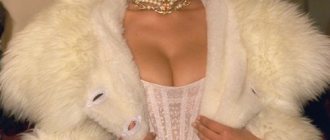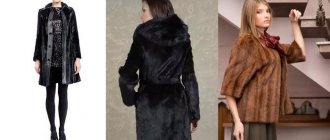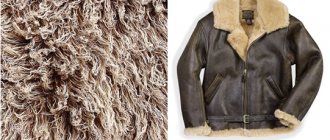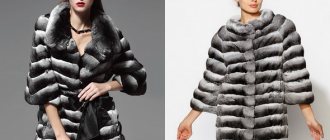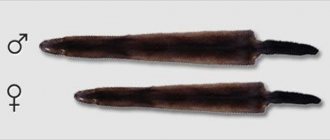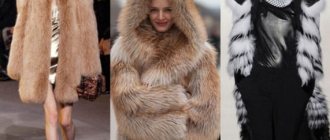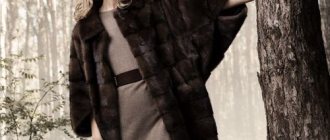Features and Benefits
Fur products are still attractive and in demand. They are suitable for young and older women. The items are practical, durable to wear, and last a long time.
The advantages of natural fur are obvious:
- Warms in the most severe frosts.
- Lets air through and allows the body to breathe.
- Protects from wind and moisture.
- The service life is much longer than artificial ones.
- The products are distinguished by their beauty, different types of finishes, and colors.
- Models - fitted, with or without a belt, long, short, some exclusive.
The presence of an expensive item determines a person’s status and material wealth.
Where to start?
When the decision to buy a fur coat has been made, you need to answer several important questions:
- Where to buy? It is best to purchase this expensive product in a specialized salon or store. Study customer reviews of the outlet, make sure that the salon has been operating for several years and has earned a certain reputation. A reputable store must provide a guarantee on the product for a period of one year (usually). If during this time any shortcomings appear, you can exchange the fur coats or get your money back. If you buy it on the market, even if the product falls apart on the same day, it will be difficult to correct the situation.
- When to wear it? A short fur coat is suitable for traveling in a car, but for long walks in the fresh air you need something longer.
- Price issue. The longer the fur coat lasts, the more you will have to pay for it. Fur differs not only in appearance and quality of manufacture, the wear time of the product will depend on the “pedigree” of the skin. The longest-lasting fur coats are made from otter. Then in descending order: beaver, raccoon, mink, astrakhan fur, nutria, muskrat. The worst types of fur to wear are rabbit, hare and goat fur.
Selection by length
Depending on their figure and preferences, ladies can afford a fur coat of any length.
Short
Practical and comfortable for active ladies, a fur coat can be worn with fashionable tight trousers, skirts and high boots. Recommended for those with short stature.
Average
Universal length, suitable for all girls, up to mid-thigh, suitable for a rectangle figure. For footwear, classic boots are recommended.
Long
An evening option for going out, they look luxurious and beautiful, but are impractical, the bottom risks getting dirty in bad weather. Suitable for tall girls, for thin girls they will look good with a belt and suede ankle boots.
Types of fur
Furs are divided into the most expensive ones, those with average prices and cheaper ones.
Sable
It is distinguished by thick, silky fur with a signature shine, strength and lightness, and warms in any frost. Experts know what kind of skins are found; the most common are Barguzin, Yakut, Kamchatka, and Amur.
Marten
The fur of a predatory and dangerous animal is a real luxury item; it is hypoallergenic and has breathable functions. Products made from marten are very expensive, since the animals are not specially bred. There are pine and stone martens.
Fox
Outerwear made of fox fur looks luxurious; it is made with horizontal and vertical stripes. Fur coats made from pieces are in demand due to their extraordinary models and reasonable prices.
See also
What can you wear with a burgundy skirt and a review of stylish models, combination rules
Mink
The fur market is dominated by mink skins raised in special conditions. The animal's fur is thick and wear-resistant; varieties are divided by color and size.
Arctic fox
The animal lives in the Northern Hemisphere, where temperatures are very low. Its fur is dense, long, thick. Protects from cold, strong wind, lasts more than 10 seasons.
Raccoon
Women's raccoon fur coats are wear-resistant, up to 15 seasons. The North American animal is valued for its shine, warmth, and thick undercoat. Used for finishing or combining with other materials.
Otter
Outerwear is made from wild otter fur; it is rare and elite, wear-resistant. Animals do not live in captivity; they obtain fur only by hunting.
Nutria
Resistant to rain and snow, warm, light, durable. The sheared one looks like mink, the price is cheaper.
Muskrat
The musk rat, or muskrat, lives in North America. Fur coats are inexpensive, soft, and ideal for every day. They protect from moisture, wind, cold, but after a few seasons they lose their appearance.
Beaver
Products made from beaver are rare; the animal is not raised in captivity. If the label indicates beaver fur, the product is made from a royal rabbit. Fur coats made from natural beaver are very expensive, warm, and are not afraid of moisture.
Polecat
A predator of the mammalian genus or ferret, there is a forest and steppe species. The villi are heterogeneous in height and color. The products are warm, soft, moisture-resistant, lightweight. With careful care they can be worn for 5 seasons, cheaper than mink.
Chinchilla
A unique animal with thick fur. The dark gray to white color adds charm to the finished product. The models are mostly short - vests, short fur coats.
Rabbit
The colors and models of fur coats are varied, inexpensive, and lightweight. The downside is that the products wear out quickly. They are not particularly warm. The most popular is the Rex rabbit.
Astrakhan
Skins of Karakul lambs aged 1-3 days. Colors: black, grey, silver, platinum. Each skin has unique curls and patterns. They sew coats, suits, jackets, boleros. Able to warm only at -15 C.
Wolf
A wolf fur coat is an element of a fashionable look. The fur is durable, fluffy, warm, lasts a long time, and has water-repellent properties. The model range is varied - short, medium length, with a hood, with leather inserts.
Seal
Looks elite and stylish. Products made from it stand out from the rest thanks to its unique natural texture, which changes depending on the animal’s habitat and time of year. The fur of the harp seal, khokhloch, and serk is popular. The item can be worn for up to 20 seasons; after snow and rain, no special care is required. In addition to outerwear for men and women, they sew hats and accessories.
Squirrel
The skins of the animal are fragile and delicate; products are often taken for special occasions; clothes will last only 2-3 years. A squirrel fur coat is not suitable for severe frost. Fur goes well with others; designers combine it with fox, raccoon, and marten. Short or midi models are rarely sewn too long, they are impractical and expensive. Color: gray, chocolate, black, red.
See also
What can be harmoniously combined with and how to wear a lace skirt correctly, the best models and looks
Badger
Badger fur coats are durable and durable, and can be dyed in different colors. With the new Italian processing of the material, the products are light and practical. They combine fur with textile materials and other types. Plucked is used for outerwear, unplucked for finishing.
Leopard
Not everyone can afford a product made from natural leopard; it costs several thousand dollars. Much more common is natural or faux fur with animal print. The designs are very different, purple, green.
Ocelot
The graceful animal lives in South and North America. The advantages of fur are its bright, unusual color, shine, practicality, and durability. Such products are exclusive and rare.
Lynx
Lynx fur is valuable and rare; it is obtained in Canada; animals are not bred in captivity. This expensive fur is not dyed; it looks very beautiful in its natural form. Fur coats are durable and resistant to frost.
Jaguar
One of the most expensive furs, jaguar fur coats and accessories are rarely found in salons and boutiques around the world. There is a white mink skin with jagged spots called jaguar.
Mole
The fur of the animal is shiny, smooth, beautiful. Disadvantages - it gets dirty, is not easy to clean, it is classified as cold. But the products are expensive, unusual, and in demand.
Pony
Pony fur, similar to velvet or plush, is gaining popularity among fashionistas. Designers subject fur to different treatments and colors. They make fur coats, jackets, jackets, and accessories from it.
Raccoon dog
The Ussuri raccoon is distinguished by thick skin tissue. Its colors are golden, silver, and sometimes white. The fur is warm, thick, and the fluff is longer than that of the Arctic fox.
Muskrat
A small animal of the mole family. The fur is thick, with a velvety shine, the hairs are dense at the tips, tapering at the roots. Keeps warm, durable, lasts a long time, is not afraid of cold and moisture.
Gopher
The gopher's fur is short, thick, and fluffy. The products are beautiful, but not very warm, are not wear-resistant, and will last 2-3 seasons. They sew fur coats, hats, and vests from gophers.
Alpaca
A rare animal, its wool is obtained only once a year. Fur can be dyed; fashionistas choose the color to their liking. Recommended for dry weather. The price of the products is low. The quality is excellent and will last a long time.
Bear
Bear fur is at the peak of popularity due to its unique properties. Polar and brown bear clothing differs significantly from each other. The fur is characterized by smoothness, elasticity, and shine. It is moisture resistant, it is impossible to freeze in it. Disadvantages: heavy weight of the product and high price.
Yak
The animal's fur is long, shades of brown, gray, dirty yellow. The fur coat will not get wet, it is light, warm, wear-resistant, hypoallergenic. It has an exotic, catchy look.
Column
A very rare animal, it is raised on special farms. The fur is warm and light, but not suitable for very cold regions. They create a variety of styles, are suitable for youth clothing, and will last at least 5 seasons.
Kangaroo
The original fur is not so popular, but wearable. Good for warm regions. Natural color is brown, light red, sometimes painted black. There are different styles - short, long, with a belt.
See also
Features and fashionable models of mink short fur coats, what to wear with them
Opossum
A small animal lives in America and Canada, light in color, with dark tips of hairs. The fur is delicate and soft, warms well. Light and airy short fur coats are made from it.
Weasel
It looks expensive and elegant, but is colder than mink and doesn’t last long. The predatory animal is very small; its fur coats are short. The colors are different, the products made from white weasel are especially beautiful.
Honorik
A rare fur-bearing animal, a hybrid of mink and ferret. It has shiny, velvety, pleasant to the touch and beautiful fur. Wear-resistant, retains heat in the coldest weather, protects from dampness. The price is slightly lower than mink.
Tiger
A rare animal, listed in the Red Book. Fur coats similar to tiger fur are made from artificial material.
Review of popular materials on the domestic market
Russian consumers are offered more than 100 types of furs and furs obtained from hunting farms, obtained from animal nurseries, supplied from farm or domestic animals.
For several centuries, sable has remained the elite fur. It is available in several colors: from sand to dark brown. The look with a dark base and grayish-blue ends of the hairline is considered especially refined.
The fur of an animal greatly depends on its habitat (ridge):
- Barguzin individuals have a beautiful color and silkiness.
- Yakut animals have good quality fur.
- Representatives of Kamchatka are gaining popularity. Based on the results of recent fairs, it became obvious that its price already exceeds the cost of Barguzin sable.
- The price also increased, outstripping the prices for the fur of Yenisei animals and Amur sable.
Uninformed buyers may mistake the skins of marten or kidus (the product of crossing sable with marten) for sable fur.
The marten has less lush, soft, silky hair than all types of sables. The appearance of marten fur greatly depends on the place where the animals live:
- The domestic market offers furs from the northern regions, Kuban, the Caucasus and Central Asia.
- You can see products made from marten fur brought from Canada for sale. It is distinguished by its heavy weight, blurred coloring, and is often called Canadian sable.
The fur market offers a large number of fox skins, both free and caged.
- The most expensive fur of red animals with various red shades.
- Red furs with grayish tints are less valuable.
The fur of animals from the Urals, Siberia and the North is distinguished by its lushness and silkiness. The further south the location of the animals is, the coarser the appearance of their fur.
- The furs of free steppe foxes are supplied from Central Asia and Kazakhstan. They have all shades of gray.
- Animals in the Lower Volga region are sand-colored with a reddish or gray color.
- For experimental model products, the hair of animals after mutations is sometimes used. These are creative products of a high price category.
The fur of cellular animals has excellent qualities. It is different:
- long, elastic hair;
- uniform, varied color - platinum, silver-black, snow-white.
The best fur in this group is considered to be blue-black skins with light bluish, silvery down.
Mink coats occupy a special place in the group of fur products. These are always expensive, fashion products.
It is useful to know that the skins of males are large and have high hair. They cost more.
The quality of mink differs markedly among individuals from different ridges.
- Animals that are hunted have black fur with blue fluff, dark or light shades of brown.
- Commercial minks are mined in Siberia, the North and the Caucasus.
- Animals raised in cages have uniformly high, soft fur. They have a long beautiful tail. On average, caged animals are larger than free-ranging animals. Perhaps this is due to good living conditions and the absence of the need to obtain food.
Through the efforts of breeders, a huge number of types have been created based on the American mink.
- Russian animals are adapted to moisture. Their fur is much warmer, a little more shaggy, than that of their American ancestors.
- There are many coats made from Scandinavian mink fur on the domestic market. It is also well suited to Russian climatic conditions.
The fur of animals raised in cages can have different colors. Experts count 17 groups of colors, each of which has many shades. Prices for caged animal fur are largely determined by fashion and demand. They can differ significantly with quite comparable quality.
It is important to know that some manufacturers may dye mink fur, “forgetting” to inform the buyer about it. This is often how they get an imitation of expensive, dark fur from not very beautiful light fur.
How to identify real fur
Even branded manufacturers produce products made from faux fur, and it can be difficult to distinguish it from natural fur. When choosing, you should consider many nuances:
- The fur should be thick and dense.
- When stroking in different directions, the hairs do not bend or break; there is a thick down underneath them.
- The skins can be wrinkled, squeezed, and they will regain their former appearance.
- When you pass a damp cloth over the product, there will be no marks on it, and if you move the hairs apart, the skin underneath will appear white.
- Reputable manufacturers do not sew the lining tightly.
- Natural fur is soft to the touch, passes through your fingers, and falls in smooth stripes.
- It is difficult to pierce the product with a pin.
- The unusual color indicates the artificial origin of the fur clothing.
Information on the label and certificate of conformity will help clarify what a fur coat or other product is made of.
Beaver
Typically, it takes 9-10 beavers to make one fur coat. Beaver fur is thick, shiny and warm, and its colors range from dark brown to silver. Beaver coats can also be either natural or clipped, and require annual professional cleaning and proper care. For example, moisture is contraindicated for them.
Stylish looks
With the help of a natural fur coat you can create a very fashionable look.
A fur coat made of patches with black leather trousers and wedge ankle boots is an option for every day; a bright shawl and hat will complement the look.
A mink coat and a bright downy scarf will add a retro style to your fashionable look.
A straight model with a hood is combined with a cropped knitted dress and knee-high boots. A flared fur coat with a hood and boots with flat soles look beautiful.
A classic-length lynx fur coat with an insert on the astrakhan belt and flared sleeves with a short, narrow, black skirt will create a luxurious, fashionable look.
Lynx
It takes 11 lynxes to make one fur coat. These large spotted cats live in Europe, Canada and the USA. In Russia, the white lynx is on the verge of extinction and is therefore a protected animal. However, the state allows the sale of a limited number of white pelts per year. The lynx coat is very soft, has a long pile and does not shed.
And as a bonus, we offer you to learn how to choose a mink coat. Don't miss the video below!
Stylist tips
Stylists recommend taking into account the purpose of the clothing when choosing. For every day or going out. The fur coat must correspond to the parameters of the figure. Tight-fitting styles are not for plus size women. Petite girls should not settle for a long, flared model.
With a full bust and wide hips, a shortened version in the shape of a trapezoid is recommended. For tall and thin ladies, sable, arctic fox, and transverse mink are suitable.
The black color of the product suits overweight women; light shades are recommended for slim women. With the color type “autumn” and “spring” you can use warm tones, for “winter” and “summer” - cold tones.
It is better to wear a hat with the same fur as a fur coat. Scarves, scarves, and shawls have become popular.
Long-haired animals
Such animals include the wolf. His coat has two layers and good length. One layer is responsible for cleanliness, the second for frost resistance. The color of the wolf is varied, from light to dark and brown shades. Wolf fur coats look quite stylish and unusual due to their color and texture. Foxes also have long fur. There are many types of colors, as well as breeds of foxes. There are more than 20 colors, the most popular being red with black spots. The fur is double-haired, due to this it shimmers beautifully in the sun. Silver fox fur is another rare species. The hair has 3 colors, the whiter the middle, the more expensive. Such foxes live in the northern regions, the fur is very warm and high quality, and is worn for at least five years. The Arctic fox is very thick and has long hair. Blue lasts about 12 seasons, white a little less, about nine. The thicker the pile, the better and warmer the fur coat. Yak fur is very long, the animals are huge, and the color in nature is very dark. The material has useful properties, it is elastic and will fit any figure.

